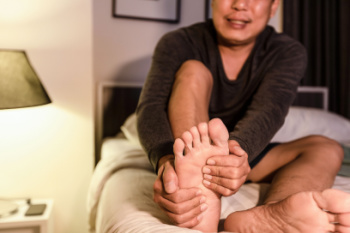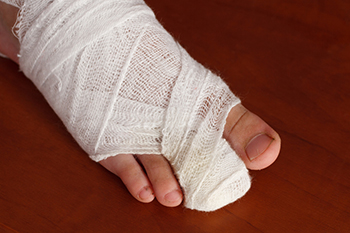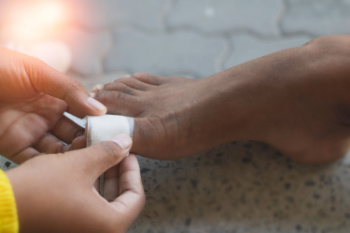Items filtered by date: May 2024
Choosing Walking Versus Running Shoes

When it comes to walking versus running, the distinction goes beyond just pace and intensity. As experts note, the mechanics of each activity necessitate specific footwear for walking and running. For walkers, shoes with soft, flexible soles are recommended to absorb the impact of each step and facilitate the rolling motion from heel to toe. Runners require thicker-soled shoes for ample shock absorption, given the varied striking points on the foot during a run. It is important to remember that while running shoes can serve for walking, the reverse is not recommended by experts. Footwear plays a critical role in preventing foot injuries like plantar fasciitis and Achilles tendonitis, but shoes alone cannot resolve existing issues. Seeking guidance from a podiatrist is essential if foot discomfort persists. To ensure the right shoe fit, have your arch and gait evaluated. For advice with foot pain related to either walking or running, it is suggested that you schedule an appointment with a podiatrist for a full exam and diagnosis. The appropriate treatment options will follow, including suggestions on the right type footwear for the activity.
For more information about walking shoes versus running shoes, consult with Cory Brown, DPM from Cory Brown, DPM. Our doctor can measure your feet to determine what your needs are and help you find an appropriate pair of footwear.
Foot Health: The Differences between Walking & Running Shoes
There are great ways to stay in shape: running and walking are two great exercises to a healthy lifestyle. It is important to know that running shoes and walking shoes are not interchangeable. There is a key difference on how the feet hit the ground when someone is running or walking. This is why one should be aware that a shoe is designed differently for each activity.
You may be asking yourself what the real differences are between walking and running shoes and the answers may shock you.
Differences
Walking doesn’t involve as much stress or impact on the feet as running does. However, this doesn’t mean that you should be any less prepared. When you’re walking, you land on your heels and have your foot roll forward. This rolling motion requires additional support to the feet.
Flexibility – Walking shoes are designed to have soft, flexible soles. This allows the walker to push off easily with each step.
If you have any questions, please feel free to contact our office located in Lewiston, ID . We offer the newest diagnostic and treatment technologies for all your foot care needs.
Are You Suffering From Ingrown Toenails?
The Impact of Neuropathy on Feet

Neuropathy, often silently lurking until later stages of life, can significantly impact foot health. It is a condition characterized by nerve damage, leading to numbness, tingling, and pain in the feet. Causes range from diabetes and infections to injuries and hereditary factors. Neuropathy can manifest in various foot problems, including loss of sensation, burning or shooting pain, and muscle weakness, making simple tasks challenging. Diagnosing neuropathy typically involves a thorough medical history, physical examination, and nerve conduction tests to assess nerve function. Prevention strategies include managing underlying conditions like diabetes, maintaining a healthy lifestyle, and avoiding prolonged pressure or trauma to the feet. While there is no outright cure for neuropathy, treatments focus on symptom management and slowing its progression. This may involve medications and lifestyle modifications. If you are experiencing symptoms of neuropathy in your feet, it is suggested that you consult a podiatrist for a thorough exam and tailored treatment plans.
Neuropathy
Neuropathy can be a potentially serious condition, especially if it is left undiagnosed. If you have any concerns that you may be experiencing nerve loss in your feet, consult with Cory Brown, DPM from Cory Brown, DPM. Our doctor will assess your condition and provide you with quality foot and ankle treatment for neuropathy.
What Is Neuropathy?
Neuropathy is a condition that leads to damage to the nerves in the body. Peripheral neuropathy, or neuropathy that affects your peripheral nervous system, usually occurs in the feet. Neuropathy can be triggered by a number of different causes. Such causes include diabetes, infections, cancers, disorders, and toxic substances.
Symptoms of Neuropathy Include:
- Numbness
- Sensation loss
- Prickling and tingling sensations
- Throbbing, freezing, burning pains
- Muscle weakness
Those with diabetes are at serious risk due to being unable to feel an ulcer on their feet. Diabetics usually also suffer from poor blood circulation. This can lead to the wound not healing, infections occurring, and the limb may have to be amputated.
Treatment
To treat neuropathy in the foot, podiatrists will first diagnose the cause of the neuropathy. Figuring out the underlying cause of the neuropathy will allow the podiatrist to prescribe the best treatment, whether it be caused by diabetes, toxic substance exposure, infection, etc. If the nerve has not died, then it’s possible that sensation may be able to return to the foot.
Pain medication may be issued for pain. Electrical nerve stimulation can be used to stimulate nerves. If the neuropathy is caused from pressure on the nerves, then surgery may be necessary.
If you have any questions, please feel free to contact our office located in Lewiston, ID . We offer the newest diagnostic and treatment technologies for all your foot care needs.
Broken Toe Causes and Treatment

Broken toes, or toe fractures, typically occur when the toe experiences a sudden impact or pressure. This may be due to a heavy object falling on it or stubbing it against a hard surface, like furniture or steps. Symptoms of a broken toe include pain, swelling, and discoloration of the toenail because of trapped blood underneath. Fractures of the big toe potentially cause more intense pain, increased swelling, and bruising, which affects mobility. Diagnosis of a fractured toe is usually made through a physical examination by a podiatrist, often without the need for X-rays. Treatment may involve buddy taping, which is securing the injured toe to the adjacent one for support. Draining trapped blood under the toenail to help alleviate discomfort. A podiatrist also may prescribe wearing comfortable footwear or a protective boot to aid healing. In more serious cases, surgery may be required to correct the injury. For an exam, personalized guidance, and proper treatment of a broken toe, it is suggested that you schedule an appointment with a podiatrist.
Broken toes may cause a lot of pain and should be treated as soon as possible. If you have any concerns about your feet, contact Cory Brown, DPM from Cory Brown, DPM. Our doctor will treat your foot and ankle needs.
What Is a Broken Toe?
A broken toe occurs when one or more of the toe bones of the foot are broken after an injury. Injuries such as stubbing your toe or dropping a heavy object on it may cause a toe fracture.
Symptoms of a Broken Toe
- Swelling
- Pain (with/without wearing shoes)
- Stiffness
- Nail Injury
Although the injured toe should be monitored daily, it is especially important to have a podiatrist look at your toe if you have severe symptoms. Some of these symptoms include worsening or new pain that is not relieved with medication, sores, redness, or open wounds near the toe.
If you have any questions, please feel free to contact our office located in Lewiston, ID . We offer the newest diagnostic and treatment technologies for all your foot care needs.
Telltale Signs and Causes of Foot Blisters

Foot blisters can cause discomfort and inconvenience, particularly for individuals who spend long hours on their feet. These fluid filled sacs often develop as a result of friction, heat, or pressure on the skin. One of the primary signs of a blister is a raised, fluid-filled bump on the skin's surface, which may be painful or tender to the touch. Blisters can occur due to wearing ill-fitting shoes, excessive moisture, or repetitive movements that cause rubbing or chafing. Additionally, activities such as running, hiking, or wearing new shoes for extended periods can increase the risk of blister formation. Certain medical conditions, such as eczema or athlete's foot, can also predispose individuals to blisters. Foot blisters can be bothersome and may become infected. If this pertains to you, it is suggested that you visit a podiatrist who can determine the cause and effectively treat blisters on the feet.
Blisters are prone to making everyday activities extremely uncomfortable. If your feet are hurting, contact Cory Brown, DPM of Cory Brown, DPM. Our doctor can provide the care you need to keep you pain-free and on your feet.
Foot Blisters
Foot blisters develop as a result of constantly wearing tight or ill-fitting footwear. This happens due to the constant rubbing from the shoe, which can often lead to pain.
What Are Foot Blisters?
A foot blister is a small fluid-filled pocket that forms on the upper-most layer of the skin. Blisters are filled with clear fluid and can lead to blood drainage or pus if the area becomes infected.
How Do Blisters Form?
Blisters on the feet are often the result of constant friction of skin and material, usually by shoe rubbing. Walking in sandals, boots, or shoes that don’t fit properly for long periods of time can result in a blister. Having consistent foot moisture and humidity can easily lead to blister formation.
Prevention & Treatment
It is important to properly care for the affected area in order to prevent infection and ease the pain. Do not lance the blister and use a Band-Aid to provide pain relief. Also, be sure to keep your feet dry and wear proper fitting shoes. If you see blood or pus in a blister, seek assistance from a podiatrist.
If you have any questions, please feel free to contact our office located in Lewiston, ID . We offer the newest diagnostic and treatment technologies for all your foot care needs.

